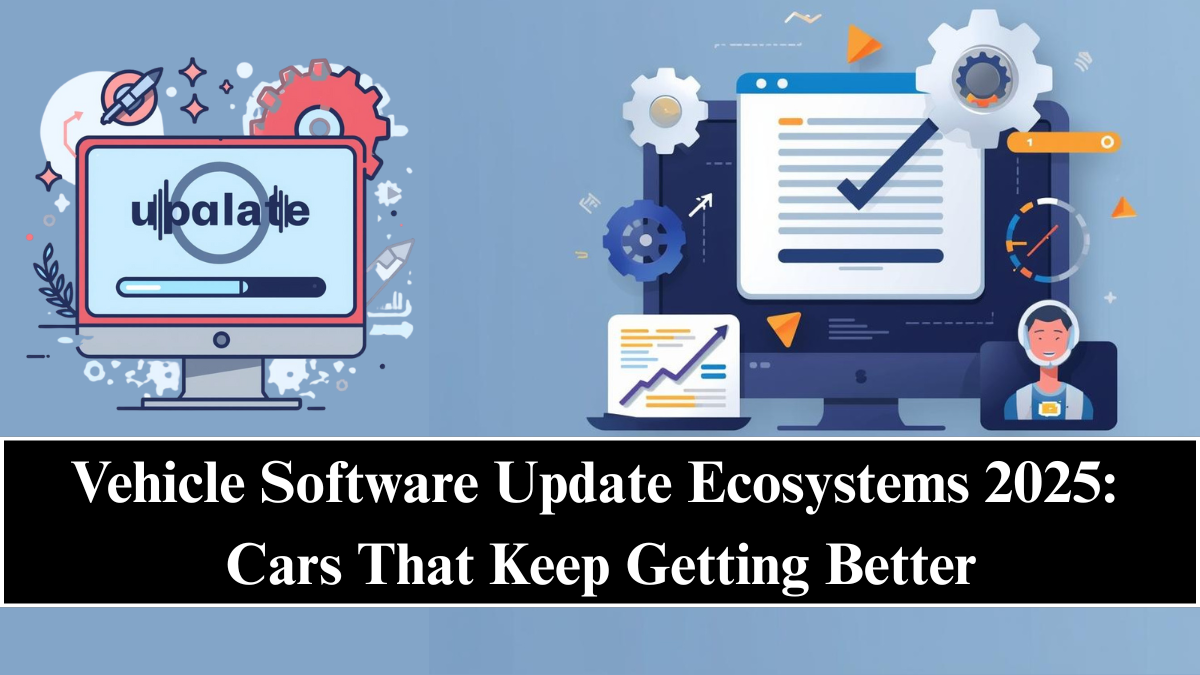In 2025, cars have become more like computers on wheels than traditional mechanical machines. The rise of vehicle software update ecosystems—powered by Over-The-Air (OTA) updates and software-defined vehicle (SDV) technology—has changed how automakers deliver performance, safety, and new features. Vehicles no longer remain static after purchase; instead, they continuously evolve, improving functionality and efficiency over time.

The Shift Toward Software-Defined Vehicles
A software-defined vehicle (SDV) is one where most vehicle functions—from infotainment to power management—are controlled through software, rather than fixed hardware. This concept allows automakers to remotely modify systems using cloud-based updates, much like how smartphones receive app upgrades.
In 2025, every major automaker, including Tesla, BMW, Mercedes-Benz, Hyundai, and Ford, is adopting this model. Their vehicles can receive new features, enhanced safety systems, or performance boosts without stepping into a service center.
How Over-The-Air (OTA) Updates Work
Over-The-Air updates are delivered through secure, encrypted cloud connections. These updates can target:
-
Infotainment systems (navigation, entertainment apps, voice assistants)
-
Battery management systems (BMS) for EV range optimization
-
ADAS (Advanced Driver Assistance Systems) for improved safety algorithms
-
Performance tuning (throttle response, regenerative braking, or motor calibration)
-
Cybersecurity patches to protect against vulnerabilities
The OTA ecosystem is backed by powerful edge computing networks and vehicle-to-cloud (V2C) communication, ensuring fast and secure data transfer even on the move.
Leading Automakers in the OTA Revolution
-
Tesla pioneered real-time feature updates, from acceleration boosts to autonomous driving capabilities.
-
BMW’s ConnectedDrive and Mercedes-Benz’s MB.OS now allow in-car purchases, system upgrades, and personalization through OTA.
-
Hyundai’s E-GMP platform supports modular updates across all models, improving charging speed and energy management.
-
Ford’s Power-Up system introduces new driver-assist features and UI improvements remotely.
This has led to a world where car owners wake up to new features overnight—turning every vehicle into a dynamic, evolving product.
The Economics of Software in the Automotive Industry
For automakers, the rise of OTA updates has unlocked new revenue models. Instead of a one-time sale, manufacturers now sell subscription-based features such as premium navigation, self-parking, or adaptive lighting.
According to 2025 industry projections:
-
The global automotive software market is valued at $320 billion, with OTA services contributing nearly 25%.
-
Automakers like Tesla and BMW earn up to $1,000 per vehicle annually through digital upgrades.
This transformation turns every vehicle into a long-term revenue stream, reshaping how car companies sustain profitability.
Benefits of Vehicle Software Update Ecosystems
-
Enhanced Longevity: Cars stay up-to-date without needing new hardware.
-
Improved Safety: Real-time patching prevents software vulnerabilities.
-
Lower Maintenance Costs: Minor bugs and faults are resolved remotely.
-
Sustainability: Reduces physical recalls and waste, minimizing environmental impact.
Essentially, a vehicle’s life cycle is now measured in software iterations, not just mileage.
The Challenges of Always-Connected Cars
While OTA brings convenience, it also raises concerns around data privacy, connectivity dependency, and cybersecurity. Unauthorized access to vehicle data or control systems could pose risks.
To mitigate this:
-
Automakers use blockchain-based encryption and multi-factor authentication.
-
Regulatory bodies like UNECE WP.29 enforce cybersecurity management frameworks globally.
These measures ensure that as vehicles become smarter, they remain secure and compliant.
The Future: Self-Healing Cars and Predictive Updates
Looking ahead, AI-driven predictive maintenance will allow vehicles to detect issues before they happen and automatically download corrective patches.
Imagine your car updating its braking algorithm before you even notice a problem—this is the future of autonomous software optimization.
The ultimate goal is the “self-healing car” — an intelligent vehicle that manages, protects, and enhances itself without human intervention.
FAQs
What is a vehicle software update ecosystem?
It’s a system that allows automakers to deliver remote updates, improving car software, performance, and security without a physical visit to service centers.
Which automakers use OTA updates in 2025?
Major brands like Tesla, Mercedes-Benz, Hyundai, Ford, BMW, and Rivian now integrate OTA updates across most new models.
Are OTA updates safe for my car?
Yes, they’re encrypted and verified by automakers, ensuring updates are applied securely without harming system stability.
Do software updates cost money?
Some updates (like safety patches) are free, while premium performance or entertainment upgrades may require subscriptions or one-time purchases.
Can OTA updates improve performance and battery range?
Yes, many EVs gain improved efficiency and range through optimized battery algorithms and drive software delivered via OTA.
Click here to know more.
